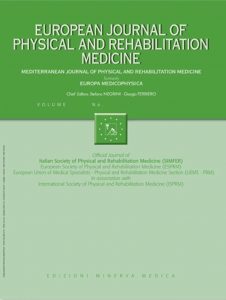Publications

Radial shock-wave therapy for frozen shoulder patients with type 2 diabetes mellitus: a pilot trial comparing two different energy levels
Authors: Tülay C. Saldiran 1, Pelin Yazgan 2, Ahmet C. Akgöl 3, Fatma K. Mutluay 4
Affiliations:
- Department of Physiotherapy and Rehabilitation, School of Health Sciences, Bitlis Eren University, Bitlis, Turkey
- Department of Physical Therapy and Medicine, Faculty of Medicine, Istanbul Okan University, Istanbul, Turkey
- Department of Physiotherapy and Rehabilitation, Faculty of Health Sciences, Istanbul Okan University, Istanbul, Turkey
- Department of Physiotherapy and Rehabilitation, Faculty of Health Sciences, Istanbul Medipol University, Istanbul, Turkey
Journal: European Journal of Physical and Rehabilitation Medicine - June 2022, Volume 58, Issue 3, Pages 412-422 (DOI: 10.23736/S1973-9087.22.07087-3)
-
Field & Applications:
- Medical
- Treatment evaluation
- Endocrinology
- Diabetes
- Musculoskeletal disorder
Background: Extracorporeal shock-wave therapy (ESWT) is highly recommended for the management of orthopedic shoulder pathologies. Yet, the clinical relevance of the dose difference effect of radial ESWT approaches in the management of frozen shoulder patients with type 2 diabetes mellitus remains uncertain.
Aim: To examine the short-term effects of medium-and high-energy levels of radial ESWT (rESWT) in the treatment of frozen shoulder patients with type 2 diabetes mellitus.
Design: Prospective clinical pilot study.
Setting: Outpatient.
Population: Thirty-nine patients who had frozen shoulder untreated for at least 3 months, diagnosed with type 2 diabetes mellitus for≥3 years were included.
Methods: The patients were randomly allocated to receive either high-energy rESWT (hrESWT), or medium-energy rESWT (mrESWT) or placebo at 8 Hz twice a week for six weeks. The primary outcome measure was pain, evaluated by the Visual Analog Scale (VAS) score. Secondary outcome measures were function evaluated by the Shoulder Pain and Disability Index (SPADI) score, and shoulder active range of motion (AROM). The mechanical properties of the deltoid and trapezius muscles were assessed using the MyotonPRO.
Results: The mrESWT resulted in statistically significant reductions in night pain at 6 weeks (ηp 2=0.27, p=0.003). Significantly improved function (SPADI scores; -35.42±21.29 vs.-29.59±22.60; ηp 2=0.39, p˂.001) was found in both hrESWT and mrESWT group by 6 weeks. Significantly higher mean shoulder AROM values were recorded for external rotation (ηp 2=0.53, p<.001), and internal rotation (ηp 2=0.21, p=0.020), in the hrESWT group at the 6th week. A significantly improved resting tone (ηp 2=0.58) and stiffness of deltoid muscle (ηp 2=0.62) were found in the mrESWT group (p<.001). The trapezius muscle resting tone reduced with hrESWT (ηp 2=0.17, p=0.033).
Conclusions: Regardless of the energy levels, rESWT appears to be an effective therapeutic intervention for frozen shoulder patients with type 2 diabetes mellitus in the short-term results.
Clinical rehabilitation impact: Our results suggest that this rESWT can be a useful strategy for the rehabilitation of frozen shoulder patients with type 2 diabetes mellitus. This is the first study on dose difference effectiveness in terms of the clinical significance of rESWT which is key to transfer research evidence into practice.
Keywords: frozen shoulder, diabetes mellitus, muscle tone, pain, shock-wave
Based on this pilot study short-term treatment results, the medium-energy rESWT seems to be the most effective option in the night pain, and deltoid muscle mechanical properties. The high-energy rESWT provides more favorable results in trapezius upper muscle mechanical properties and in the improvement of internal rotation, external rotation motions of shoulder joint. Hence, significant improvements in pain, AROM, and its reflection on functionality show that irrespective of the energy level, the rESWT may be an alternative treatment, at least in the short-term, for frozen shoulder patients with type 2 diabetes mellitus.


